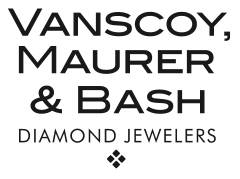The 4Cs of Diamonds
When you’re shopping for a diamond, it’s important to have a basic knowledge of the 4Cs: cut, color, clarity, and carat. Here is an overview of what you need to know about these characteristics of diamonds, and how they are graded.
Cut
Cut is the most important element; it can account for up to 60% of the price of the diamond! Cut is what gives a diamond its sparkle or brilliance. It’s more important to have a well-cut diamond than a colorless or flawless one. Many people confuse cut with diamond shape, but they are actually two separate characteristics.
Cut refers to a diamond’s engineering. A perfectly cut diamond will gather light and reflect it back to you much like a mirror and a prism reflect and split light beams. Cut also takes into account the polish, or the smoothness of the surface. Cut influences the way the diamond interacts with light. Jewelers refer to the way a diamond reflects light as its fire, which is the prismatic effect of a split beam of light into individual colors.
The Gemological Institute of America has five cut grades, while the American Gem Society (AGS) has eleven. AGS grades cut on a scale from 0 to 10, with 0 being ideal and 10 meaning poor. Ideal is rare and is reserved for only the best cut diamonds.
Back to the topColor
Diamond colors are graded on a scale from colorless to light yellow or light brown. There are also colored diamonds that come in hues like blue, red, and pink. These are considered “fancy” diamonds, and pink is the rarest and most expensive among them. GIA and AGS have different scales for evaluating colors.
GIA grades from D (colorless) to Z (vivid yellow), while AGS grades on a numbered scale from 0 to 10.
Colorless diamonds are rare. Often, it makes more sense to buy a near colorless diamond as you eye cannot see the difference from a perfectly colorless one. For example, near colorless diamonds will often appear colorless when they are mounted in a setting. You can save money by opting for a near colorless diamond.
Back to the topClarity
Clarity is determined by the presence of internal characteristics known as inclusions. Clarity grading takes into account the visibility of inclusions and how they affect the diamond’s overall appearance.
Inclusions can be so small that they are not even visible to the naked eye, so jewelers use 10x magnification to grade clarity.
Inclusions are plotted in a diagram of the diamond, and you should ask to see this report when you’re comparing diamonds. AGS grades clarity on a scale of 0 to 10. GIA uses these measurements:
- Flawless
- Internally Flawless
- VVS1
- VVS2
- VS1
- VS2
- SI1
- SI2
- I1
- I2
- I3
Keep in mind that inclusions are generally more noticeable on larger diamonds, and on diamonds with fewer facets. Also remember that in the SI range, you won’t be able to see the inclusions with the naked eye. It makes sense to aim for this range since it will save you money.
Inclusions are like the birthmarks of your diamond. They will never change. As long as you know where they are, you will know it’s your diamond.
Back to the topCarat
Carat refers to the weight of the diamond, measured in metric carats. One carat equates to one-fifth of a gram (0.200 grams), and is subdivided into 100 points (each point is 2 milligrams). For example, a 1.00 carat diamond weighs 200 milligrams.
A common misconception is that a larger carat means it’s a “better” diamond. In reality, all of the 4Cs determine the quality. A larger carat diamond could be cut poorly and thus have less brilliance.
Additionally, slight differences in carat weight can mean a large difference in price. You can opt for a slightly smaller diamond to save money, and most people will not be able to tell the difference in the two sizes.
It’s important to seek the advice of a trusted jeweler when comparing diamonds. He or she will be able to help you interpret the characteristics of the diamond and help you find one that fits you. Some customers may prefer a larger carat weight, while some may value a colorless diamond in a lower carat weight.
Back to the topHow to Evaluate the 4Cs in a Diamond
While online resources can give you a basic understanding of diamonds, it takes a trained jeweler to thoroughly understand how the 4Cs interact.
It’s good to familiarize yourself with the 4Cs and ask about them throughout the shopping process, but ultimately, a jeweler is the best source for interpreting these characteristics. Think of diamond shopping like navigating through a jungle. A trustworthy jeweler is like a local guide who can lead you through the jungle to the “treasure” of a beautiful diamond.
Vanscoy, Maurer & Bash Diamond Jewelers is a local jeweler that has been serving Lancaster for over 55 years. When you come to our store, we take the time to understand what you’re looking for. We want to be your trusted expert to help you navigate the diamond buying process. Make an appointment or stop by our store on 830 Plaza Blvd. in Lancaster, and let us help you choose the perfect diamond to express your love!

